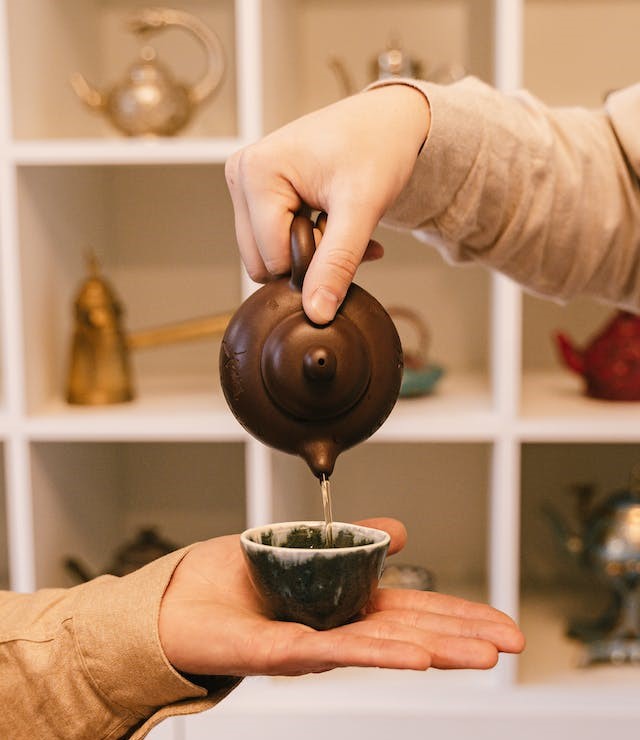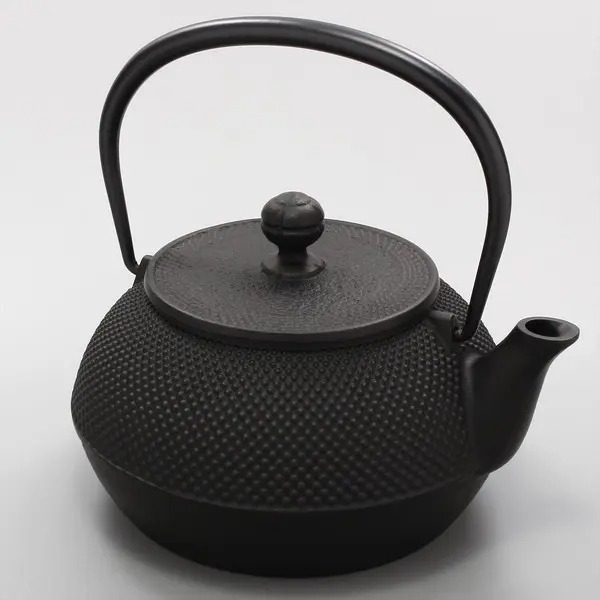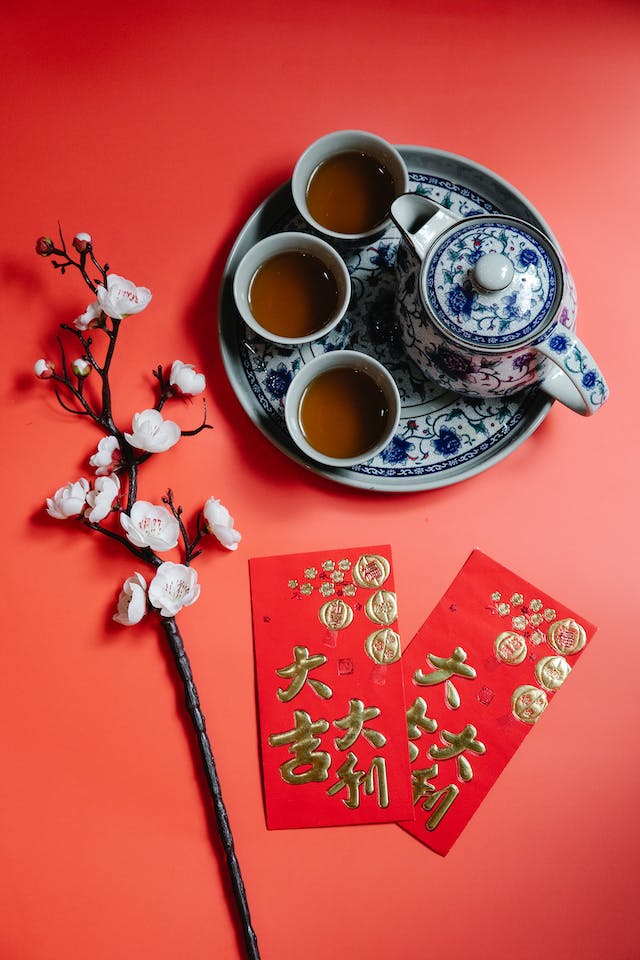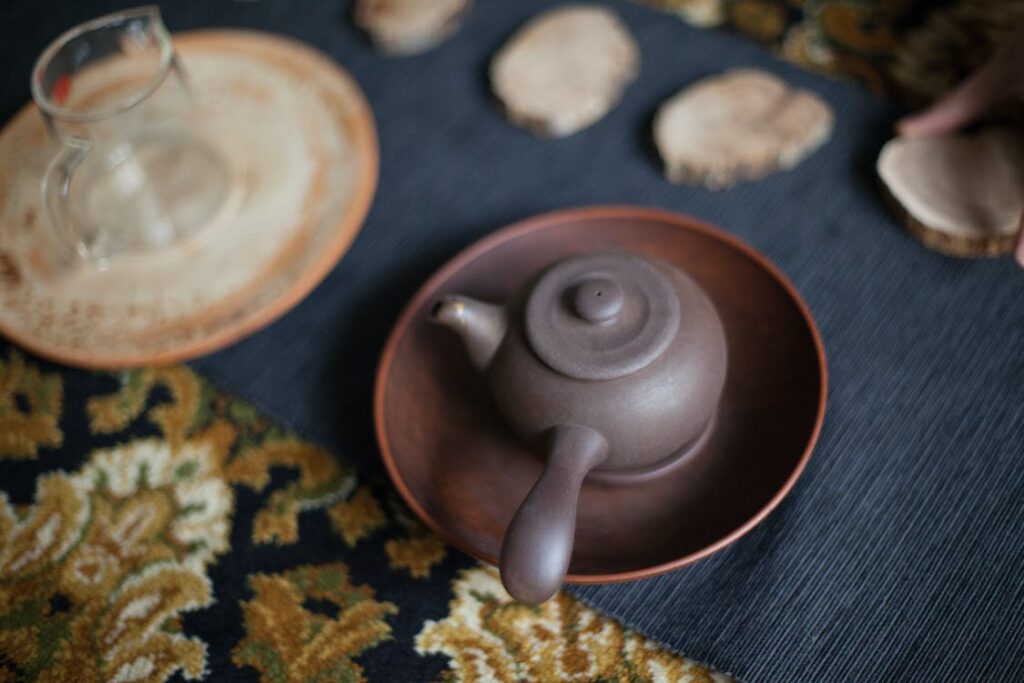Japanese teapots, also known as kyusu, are revered for their exquisite craftsmanship and centuries-old tradition. These teapots have played an integral role in Japanese
Made predominantly from ceramic materials such as porcelain and stoneware, Japanese teapots are designed to enhance the flavor and aroma of
The art of making these teapots has been passed down through generations of skilled artisans who use traditional methods to shape and fire the clay. Japanese teapots are not only functional but also highly decorative, often adorned with intricate patterns and motifs. Whether you’re a tea enthusiast or simply appreciate the beauty of Japanese craftsmanship, these teapots are a perfect addition to any


Key Takeaways
- Japanese ceramic teapots, or kyusu, are integral to the country’s
tea culture, combining functionality with centuries-old tradition and craftsmanship. - Crafted mainly from materials like clay and porcelain, these teapots enhance the flavor and aroma of
tea , with distinct styles like ushirode kyusu and yokode kyusu offering unique features. - Passed down through generations, the art of making these teapots reflects authenticity and tradition, with intricate designs adding both functionality and decorative value.
- The teapots play a crucial role in the Japanese
tea ceremony, symbolizing elegance and authenticity, and their ability to retain heat ensures a perfect brew, particularly for delicate green teas. - Beyond clay teapots, Japanese
tea culture also embraces cast iron teapots and Chinese teapots, each contributing to a diverse and richtea -drinking experience.
Definition of Japanese Ceramic Teapots


A Japanese Ceramic Teapot is a vessel used for brewing and serving
Japanese ceramic teapots are renowned for their artistic craftsmanship, showcasing intricate designs and patterns that captivate the eye. Let’s delve into the fascinating world of ceramic teapots.
Authenticity and Tradition
Handcrafted with care, Japanese ceramic teapots exude a sense of authenticity and tradition. The use of materials like clay or porcelain adds a unique touch to each teapot, reflecting the rich heritage of craftsmanship.
Varied Designs and Styles
Japanese ceramic teapots offer a wide range of designs and styles to suit individual preferences. Popular styles include the Yokode Kyusu and Ushirode Kyusu, distinguished by their distinctive handle placements. These designs not only add aesthetic appeal but also enhance the functionality of the teapot.
Integral to Japanese
Japanese ceramic teapots hold a special place in Japanese
The Perfect Brew
With their ability to retain heat and infuse
In conclusion, a Japanese ceramic teapot is a vessel crafted from clay or porcelain, designed to brew and serve
Types of Japanese Ceramic Teapots


Japanese ceramic teapots come in a wide variety of styles and designs, each offering its unique charm. One popular type is the Ushirode Kyusu, which is known for its handle placement on the back of the pot. This design allows for easy pouring and a comfortable grip.
Another style is the Yokode Kyusu, characterized by its handle on the side. This type of teapot is favored for its elegance and balance. Additionally, there are teapots with top handles, side handles, and back handles, each offering its aesthetic appeal. Japanese ceramic teapots can also be found in different materials, such as porcelain and clay.
These materials provide the perfect balance of heat retention and infusion, resulting in a rich and flavorful
Ushirode Kyusu


The Ushirode Kyusu teapot is a beautiful and functional teapot that takes inspiration from classic Chinese teapots. Its distinctive feature is the handle, which is located directly opposite the
One of the standout features of the Ushirode Kyusu teapot is its sealing lid. This lid ensures that the
This teapot is versatile and suitable for brewing both Chinese and British teas. Its design and construction make it ideal for brewing delicate green and white teas, as well as robust black teas. The Ushirode Kyusu teapot offers precise control over the brewing process, allowing you to adjust the steeping time and water temperature to achieve the perfect cup of
In conclusion, the Ushirode Kyusu teapot seamlessly combines the elegance of classic Chinese teapots with modern features. Its back-handle design and sealing lid make it a must-have for
Yokode Kyusu


The Yokode Kyusu teapot is a unique and elegant teapot style that originated in Japan. It is characterized by its distinctive side-handle design, with a narrow handle jutting out from the side of the teapot. The handle gradually widens towards the free end, creating a bulbous shape that adds a touch of aesthetic charm to the teapot.
The spout of the Yokode Kyusu teapot is conveniently located at a 90-degree angle from the handle. This ergonomic design allows for easy one-handed pouring, making it effortless to serve
The Yokode Kyusu teapot beautifully combines form and function. Its elegant shape and unique handle design make it a visually pleasing addition to any
The Yokode Kyusu teapot is a popular choice among
Porcelain Teapots


Porcelain teapots hold a significant place in Japanese
The process of creating porcelain teapots involves firing them at high temperatures, resulting in a beautifully translucent appearance. This firing process not only enhances the teapot’s aesthetic appeal but also ensures its durability and longevity.
In Japanese
The simplicity and understated elegance of porcelain teapots make them a popular choice among
Whether it’s a serene moment of solitude or a gathering of friends, brewing
Black Clay Teapots


Black Clay Teapots, also known as “kurode” teapots in Japanese, holds a significant place in the rich tradition of Japanese
One of the key characteristics of Black Clay Teapots is their ability to retain heat. The porous nature of the black clay allows the teapot to slowly release heat, ensuring that the water remains at the perfect temperature for brewing
Another notable feature of Black Clay Teapots is their ability to absorb the flavors and aromas of the
In addition to their functional qualities, Black Clay Teapots are also admired for their aesthetic appeal. The sleek and sturdy design of these teapots, often featuring a simple and elegant shape, perfectly complements the tranquility and grace of a traditional Japanese
Patterned Teapot


Patterned teapots are widely used in Japanese
The patterns on these teapots are applied using various techniques, highlighting the craftsmanship and attention to detail. Hand painting is a common method, where skilled artisans meticulously paint the designs onto the teapot’s surface, creating unique and personalized pieces. Another technique is transfer printing, which involves transferring a pre-designed pattern onto the teapot using specialized inks.
These patterned teapots not only serve a functional purpose but also add to the overall ambiance of the
Whether it’s a teapot adorned with delicate cherry blossoms or a teapot featuring traditional Japanese patterns, these patterned teapots enhance the experience of enjoying
Back-Handle Teapot


The Back-Handle Teapot is a traditional type of Japanese ceramic teapot that features a handle at the back of the pot, distinct from other designs that have handles on the side or top. This unique design is specifically crafted for the brewing of green teas such as Gyokuro or Sencha.
One of the key advantages of the back-handle design is its ability to provide easy pouring and precise control over the flow of
The Back-Handle Teapot not only showcases the craftsmanship and attention to detail of Japanese ceramic makers but also demonstrates their deep understanding of
Side-Handle Teapot


The side-handle teapot is a popular type of Japanese ceramic teapot that is commonly used for brewing
Traditionally, side-handle teapots are made of clay or porcelain, showcasing the meticulous craftsmanship of Japanese ceramic makers. The choice of material often depends on personal preference and the type of tea being brewed. Clay teapots are known for their ability to absorb flavors over time, enhancing the taste of the
The side-handle teapot combines functionality with traditional design, making it a perfect choice for
Other Types of Teapots


While Japanese ceramic teapots have gained significant admiration, it is equally captivating to explore other types of teapots, such as Japanese cast iron teapots and Chinese teapots.
Chinese teapots, known as Yixing teapots, boast a rich history spanning centuries and are revered for their exceptional craftsmanship and unique clay composition. On the other hand, Japanese cast iron teapots, also called Tetsubin, embody a harmonious blend of durability and elegance. Let’s learn more about them.
Japanese Cast Iron Teapot


The Japanese cast iron teapot, also known as a tetsubin, holds great significance in Japanese
These teapots are made through a meticulous manufacturing process that involves pouring molten iron into molds and then hand-finishing them with intricate details. This process results in teapots that are not only durable but also have excellent heat retention properties.
The durability of the cast iron teapot ensures that it will last for years, making it a worthwhile investment for
In Japanese
Chinese Teapots


Chinese teapots are renowned for their exquisite design and integral role in the art of
Chinese teapots are typically crafted from ceramic or clay, which are perfect materials for retaining heat and infusing
In addition to their aesthetic appeal, Chinese teapots are also known for their ability to enhance the flavors and aromas of different types of
Moreover, Chinese teapots hold great cultural significance. They are often associated with the traditional Chinese
Whether you’re a
Materials Used to Make Japanese Ceramic Teapots


Japanese ceramic teapots have long been admired for their exquisite craftsmanship and timeless beauty. These teapots are traditionally made using various materials, each offering unique qualities that enhance the
One of the most popular materials used to make Japanese ceramic teapots is clay. Clay teapots, also known as kyusu, are revered for their ability to absorb flavors over time, resulting in a more flavorful brew with each use. There are different types of clay used in teapot making, such as black clay and stoneware, each contributing its characteristics to the final product.
Another material commonly used for Japanese ceramic teapots is porcelain. Porcelain teapots are cherished for their elegant appearance and delicate craftsmanship. They are often adorned with intricate patterns and designs, adding a touch of grace to the
The choice of material for a Japanese ceramic teapot is a personal preference, influenced by the type of



Konnichiwa! (Hello!) I'm Pat Tokuyama, a Japanese tofu cookbook author, who travels for music, food, and adventure. If you like Japanese tea, checkout some of the newestorganic japanese tea, matcha bowls and noren and more!
** Curious about the Plant Based Japanese Cooking Club? ** Learn more here!
The Use of Clay to Make Japanese Ceramic Teapots


Clay teapots hold a significant place in Japanese
Flavor Absorption and Retention
Clay teapots excel at absorbing and retaining the flavors of green teas. The porous nature of clay allows it to capture the essence of the
Types of Clay Teapots


In Japan, different regions are known for their distinct types of clay teapots. Banko-yaki teapots from Mie Prefecture are revered for their versatility and diverse designs. Their porous clay body enhances the
Handcrafted Artistry
Clay teapots are meticulously handcrafted by skilled artisans using mineral-rich clay sourced from volcanic areas. These artisans pay meticulous attention to detail, reflecting their expertise and craftsmanship. As a result, each clay teapot is unique, showcasing individual characteristics that contribute to the overall
Elevating Green
The flavor absorption and retention properties of clay teapots make them particularly beneficial for delicate green teas. The clay’s interaction with the
Overall, clay teapots play a significant role in Japanese
Final Words
In conclusion, Japanese ceramic teapots, known as kyusu, stand as exquisite vessels embodying centuries-old tradition and craftsmanship. Crafted from materials like porcelain and stoneware, these teapots merge functionality with artistic elegance, playing a vital role in the revered Japanese
Whether you savor the rich heritage of
 4.6$16.15Buy NowPros:
4.6$16.15Buy NowPros:- The teapot is made of high-quality heatproof glass, ensuring durability and resistance to high temperatures.
- It features a large infuser, allowing for easy pouring of water and tea without any loose tea leaves ending up in your cup.
- The smooth design and comfortable handle make it easy to hold and pour.
- The in and out design of the teapot ensures precise and smooth tea transition, resulting in a perfect cup of tea every time.
- The 700ml capacity makes it suitable for brewing tea in larger quantities, making it ideal for serving guests or enjoying multiple cups yourself.
- The transparent glass design allows you to observe the steeping process, enhancing the overall tea-drinking experience.
Cons:- The teapot's fragility means it requires careful handling to prevent accidental breakage.
- The delicate design may not be suitable for those looking for a more robust teapot option.
- The high-quality materials and craftsmanship do come with a higher price tag compared to other teapot options on the market.
 4.6$49.99Buy NowProduct Specs:
4.6$49.99Buy NowProduct Specs:- Material: Porcelain
- Weight: 2.46 pounds
- Teapot Capacity: 560 ml
- Teapot Dimensions: 13 cm x 11.5 cm
- Cup Capacity: 155 ml
- Cup Dimensions: 6.5 cm x 6.5 cm
- Tray Dimensions: 33 cm x 22 cm
Pros:- Elegant and exquisite design
- High-quality white porcelain
- Delicate and intricate patterns
- Lightweight and easy to handle
- Suitable for solo or group tea sessions
Cons:- Fragile glass requires careful handling and cleaning
04/01/2025 11:02 pm GMT










Konnichiwa! (Hello!) I'm Pat Tokuyama, a Japanese tofu cookbook author, who travels for music, food, and adventure. If you like Japanese tea, checkout some of the newestorganic japanese tea, matcha bowls and noren and more!
** Curious about the Plant Based Japanese Cooking Club? ** Learn more here!